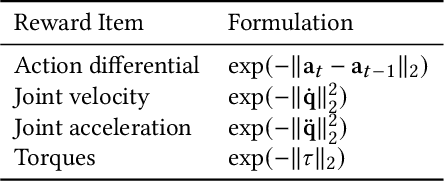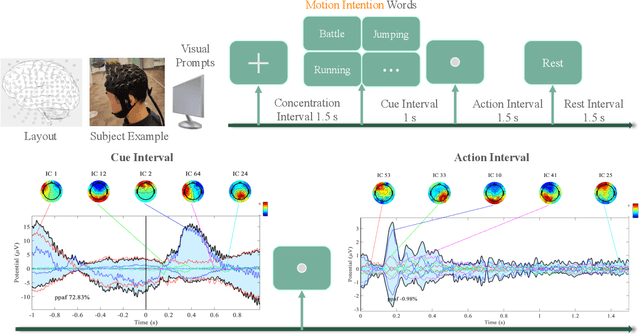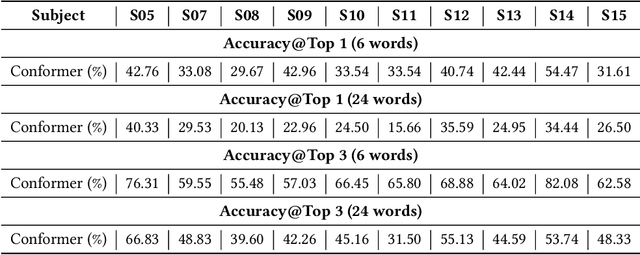Jingkai Sun
EmbodiedVSR: Dynamic Scene Graph-Guided Chain-of-Thought Reasoning for Visual Spatial Tasks
Mar 14, 2025Abstract:While multimodal large language models (MLLMs) have made groundbreaking progress in embodied intelligence, they still face significant challenges in spatial reasoning for complex long-horizon tasks. To address this gap, we propose EmbodiedVSR (Embodied Visual Spatial Reasoning), a novel framework that integrates dynamic scene graph-guided Chain-of-Thought (CoT) reasoning to enhance spatial understanding for embodied agents. By explicitly constructing structured knowledge representations through dynamic scene graphs, our method enables zero-shot spatial reasoning without task-specific fine-tuning. This approach not only disentangles intricate spatial relationships but also aligns reasoning steps with actionable environmental dynamics. To rigorously evaluate performance, we introduce the eSpatial-Benchmark, a comprehensive dataset including real-world embodied scenarios with fine-grained spatial annotations and adaptive task difficulty levels. Experiments demonstrate that our framework significantly outperforms existing MLLM-based methods in accuracy and reasoning coherence, particularly in long-horizon tasks requiring iterative environment interaction. The results reveal the untapped potential of MLLMs for embodied intelligence when equipped with structured, explainable reasoning mechanisms, paving the way for more reliable deployment in real-world spatial applications. The codes and datasets will be released soon.
HumanoidPano: Hybrid Spherical Panoramic-LiDAR Cross-Modal Perception for Humanoid Robots
Mar 13, 2025Abstract:The perceptual system design for humanoid robots poses unique challenges due to inherent structural constraints that cause severe self-occlusion and limited field-of-view (FOV). We present HumanoidPano, a novel hybrid cross-modal perception framework that synergistically integrates panoramic vision and LiDAR sensing to overcome these limitations. Unlike conventional robot perception systems that rely on monocular cameras or standard multi-sensor configurations, our method establishes geometrically-aware modality alignment through a spherical vision transformer, enabling seamless fusion of 360 visual context with LiDAR's precise depth measurements. First, Spherical Geometry-aware Constraints (SGC) leverage panoramic camera ray properties to guide distortion-regularized sampling offsets for geometric alignment. Second, Spatial Deformable Attention (SDA) aggregates hierarchical 3D features via spherical offsets, enabling efficient 360{\deg}-to-BEV fusion with geometrically complete object representations. Third, Panoramic Augmentation (AUG) combines cross-view transformations and semantic alignment to enhance BEV-panoramic feature consistency during data augmentation. Extensive evaluations demonstrate state-of-the-art performance on the 360BEV-Matterport benchmark. Real-world deployment on humanoid platforms validates the system's capability to generate accurate BEV segmentation maps through panoramic-LiDAR co-perception, directly enabling downstream navigation tasks in complex environments. Our work establishes a new paradigm for embodied perception in humanoid robotics.
ES-Parkour: Advanced Robot Parkour with Bio-inspired Event Camera and Spiking Neural Network
Mar 13, 2025Abstract:In recent years, quadruped robotics has advanced significantly, particularly in perception and motion control via reinforcement learning, enabling complex motions in challenging environments. Visual sensors like depth cameras enhance stability and robustness but face limitations, such as low operating frequencies relative to joint control and sensitivity to lighting, which hinder outdoor deployment. Additionally, deep neural networks in sensor and control systems increase computational demands. To address these issues, we introduce spiking neural networks (SNNs) and event cameras to perform a challenging quadruped parkour task. Event cameras capture dynamic visual data, while SNNs efficiently process spike sequences, mimicking biological perception. Experimental results demonstrate that this approach significantly outperforms traditional models, achieving excellent parkour performance with just 11.7% of the energy consumption of an artificial neural network (ANN)-based model, yielding an 88.3% energy reduction. By integrating event cameras with SNNs, our work advances robotic reinforcement learning and opens new possibilities for applications in demanding environments.
Trinity: A Modular Humanoid Robot AI System
Mar 11, 2025Abstract:In recent years, research on humanoid robots has garnered increasing attention. With breakthroughs in various types of artificial intelligence algorithms, embodied intelligence, exemplified by humanoid robots, has been highly anticipated. The advancements in reinforcement learning (RL) algorithms have significantly improved the motion control and generalization capabilities of humanoid robots. Simultaneously, the groundbreaking progress in large language models (LLM) and visual language models (VLM) has brought more possibilities and imagination to humanoid robots. LLM enables humanoid robots to understand complex tasks from language instructions and perform long-term task planning, while VLM greatly enhances the robots' understanding and interaction with their environment. This paper introduces \textcolor{magenta}{Trinity}, a novel AI system for humanoid robots that integrates RL, LLM, and VLM. By combining these technologies, Trinity enables efficient control of humanoid robots in complex environments. This innovative approach not only enhances the capabilities but also opens new avenues for future research and applications of humanoid robotics.
LiPS: Large-Scale Humanoid Robot Reinforcement Learning with Parallel-Series Structures
Mar 11, 2025Abstract:In recent years, research on humanoid robots has garnered significant attention, particularly in reinforcement learning based control algorithms, which have achieved major breakthroughs. Compared to traditional model-based control algorithms, reinforcement learning based algorithms demonstrate substantial advantages in handling complex tasks. Leveraging the large-scale parallel computing capabilities of GPUs, contemporary humanoid robots can undergo extensive parallel training in simulated environments. A physical simulation platform capable of large-scale parallel training is crucial for the development of humanoid robots. As one of the most complex robot forms, humanoid robots typically possess intricate mechanical structures, encompassing numerous series and parallel mechanisms. However, many reinforcement learning based humanoid robot control algorithms currently employ open-loop topologies during training, deferring the conversion to series-parallel structures until the sim2real phase. This approach is primarily due to the limitations of physics engines, as current GPU-based physics engines often only support open-loop topologies or have limited capabilities in simulating multi-rigid-body closed-loop topologies. For enabling reinforcement learning-based humanoid robot control algorithms to train in large-scale parallel environments, we propose a novel training method LiPS. By incorporating multi-rigid-body dynamics modeling in the simulation environment, we significantly reduce the sim2real gap and the difficulty of converting to parallel structures during model deployment, thereby robustly supporting large-scale reinforcement learning for humanoid robots.
Distillation-PPO: A Novel Two-Stage Reinforcement Learning Framework for Humanoid Robot Perceptive Locomotion
Mar 11, 2025Abstract:In recent years, humanoid robots have garnered significant attention from both academia and industry due to their high adaptability to environments and human-like characteristics. With the rapid advancement of reinforcement learning, substantial progress has been made in the walking control of humanoid robots. However, existing methods still face challenges when dealing with complex environments and irregular terrains. In the field of perceptive locomotion, existing approaches are generally divided into two-stage methods and end-to-end methods. Two-stage methods first train a teacher policy in a simulated environment and then use distillation techniques, such as DAgger, to transfer the privileged information learned as latent features or actions to the student policy. End-to-end methods, on the other hand, forgo the learning of privileged information and directly learn policies from a partially observable Markov decision process (POMDP) through reinforcement learning. However, due to the lack of supervision from a teacher policy, end-to-end methods often face difficulties in training and exhibit unstable performance in real-world applications. This paper proposes an innovative two-stage perceptive locomotion framework that combines the advantages of teacher policies learned in a fully observable Markov decision process (MDP) to regularize and supervise the student policy. At the same time, it leverages the characteristics of reinforcement learning to ensure that the student policy can continue to learn in a POMDP, thereby enhancing the model's upper bound. Our experimental results demonstrate that our two-stage training framework achieves higher training efficiency and stability in simulated environments, while also exhibiting better robustness and generalization capabilities in real-world applications.
Event Masked Autoencoder: Point-wise Action Recognition with Event-Based Cameras
Jan 02, 2025



Abstract:Dynamic vision sensors (DVS) are bio-inspired devices that capture visual information in the form of asynchronous events, which encode changes in pixel intensity with high temporal resolution and low latency. These events provide rich motion cues that can be exploited for various computer vision tasks, such as action recognition. However, most existing DVS-based action recognition methods lose temporal information during data transformation or suffer from noise and outliers caused by sensor imperfections or environmental factors. To address these challenges, we propose a novel framework that preserves and exploits the spatiotemporal structure of event data for action recognition. Our framework consists of two main components: 1) a point-wise event masked autoencoder (MAE) that learns a compact and discriminative representation of event patches by reconstructing them from masked raw event camera points data; 2) an improved event points patch generation algorithm that leverages an event data inlier model and point-wise data augmentation techniques to enhance the quality and diversity of event points patches. To the best of our knowledge, our approach introduces the pre-train method into event camera raw points data for the first time, and we propose a novel event points patch embedding to utilize transformer-based models on event cameras.
DEL: Discrete Element Learner for Learning 3D Particle Dynamics with Neural Rendering
Oct 11, 2024



Abstract:Learning-based simulators show great potential for simulating particle dynamics when 3D groundtruth is available, but per-particle correspondences are not always accessible. The development of neural rendering presents a new solution to this field to learn 3D dynamics from 2D images by inverse rendering. However, existing approaches still suffer from ill-posed natures resulting from the 2D to 3D uncertainty, for example, specific 2D images can correspond with various 3D particle distributions. To mitigate such uncertainty, we consider a conventional, mechanically interpretable framework as the physical priors and extend it to a learning-based version. In brief, we incorporate the learnable graph kernels into the classic Discrete Element Analysis (DEA) framework to implement a novel mechanics-integrated learning system. In this case, the graph network kernels are only used for approximating some specific mechanical operators in the DEA framework rather than the whole dynamics mapping. By integrating the strong physics priors, our methods can effectively learn the dynamics of various materials from the partial 2D observations in a unified manner. Experiments show that our approach outperforms other learned simulators by a large margin in this context and is robust to different renderers, fewer training samples, and fewer camera views.
E2H: A Two-Stage Non-Invasive Neural Signal Driven Humanoid Robotic Whole-Body Control Framework
Oct 03, 2024



Abstract:Recent advancements in humanoid robotics, including the integration of hierarchical reinforcement learning-based control and the utilization of LLM planning, have significantly enhanced the ability of robots to perform complex tasks. In contrast to the highly developed humanoid robots, the human factors involved remain relatively unexplored. Directly controlling humanoid robots with the brain has already appeared in many science fiction novels, such as Pacific Rim and Gundam. In this work, we present E2H (EEG-to-Humanoid), an innovative framework that pioneers the control of humanoid robots using high-frequency non-invasive neural signals. As the none-invasive signal quality remains low in decoding precise spatial trajectory, we decompose the E2H framework in an innovative two-stage formation: 1) decoding neural signals (EEG) into semantic motion keywords, 2) utilizing LLM facilitated motion generation with a precise motion imitation control policy to realize humanoid robotics control. The method of directly driving robots with brainwave commands offers a novel approach to human-machine collaboration, especially in situations where verbal commands are impractical, such as in cases of speech impairments, space exploration, or underwater exploration, unlocking significant potential. E2H offers an exciting glimpse into the future, holding immense potential for human-computer interaction.
Mamba Policy: Towards Efficient 3D Diffusion Policy with Hybrid Selective State Models
Sep 11, 2024



Abstract:Diffusion models have been widely employed in the field of 3D manipulation due to their efficient capability to learn distributions, allowing for precise prediction of action trajectories. However, diffusion models typically rely on large parameter UNet backbones as policy networks, which can be challenging to deploy on resource-constrained devices. Recently, the Mamba model has emerged as a promising solution for efficient modeling, offering low computational complexity and strong performance in sequence modeling. In this work, we propose the Mamba Policy, a lighter but stronger policy that reduces the parameter count by over 80% compared to the original policy network while achieving superior performance. Specifically, we introduce the XMamba Block, which effectively integrates input information with conditional features and leverages a combination of Mamba and Attention mechanisms for deep feature extraction. Extensive experiments demonstrate that the Mamba Policy excels on the Adroit, Dexart, and MetaWorld datasets, requiring significantly fewer computational resources. Additionally, we highlight the Mamba Policy's enhanced robustness in long-horizon scenarios compared to baseline methods and explore the performance of various Mamba variants within the Mamba Policy framework. Our project page is in https://andycao1125.github.io/mamba_policy/.
 Add to Chrome
Add to Chrome Add to Firefox
Add to Firefox Add to Edge
Add to Edge